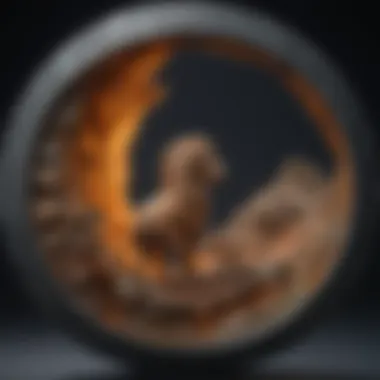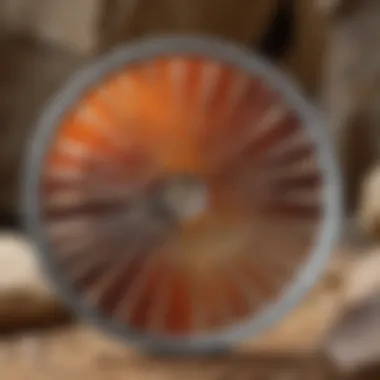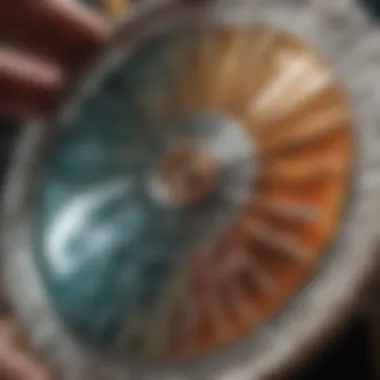Unveiling the Intricacies of Lapidary Saw Blades for Rock and Fossil Enthusiasts


Rock and Fossil Identification
When it comes to scrutinizing lapidary saw blades in-depth for rock and fossil collectors, understanding the types of rocks and fossils is fundamental. These specimens vary greatly, offering a plethora of textures, colors, and structures. Identifying key characteristics such as mineral composition, fossil imprints, and crystal formations is crucial in determining the nature and origin of the specimens. Utilizing specialized tools like magnifying glasses, ultraviolet lights, and geological hammers enhances the process of rock and fossil identification, aiding collectors in discerning the finer details with precision and accuracy.
Collecting Tips and Techniques
Delving into the realm of lapidary saw blades unveils a realm of collecting tips and techniques that elevate the experience for enthusiasts. Embracing best practices involves approaching collecting with a keen eye and delicate touch, ensuring minimal damage to delicate specimens. Locating prime collecting sites involves research, networking with fellow collectors, and exploring diverse terrains with geological significance. Safely extracting specimens requires patience and finesse, using tools like chisels, brushes, and rock hammers to carefully unearth and extract rocks and fossils without compromising their integrity.
Preservation and Display
Preservation of collected rocks and fossils is a pivotal aspect of the collector's journey. Employing various techniques like fossil cleaning pens, gentle brushing, and air scribes aids in preserving delicate specimens without causing damage. Proper storage methods involve utilizing acid-free paper, archival boxes, and silica gel packets to maintain the integrity of rocks and fossils in the collection. Creative display ideas offer collectors the opportunity to showcase their prized specimens in unique and visually appealing arrangements, enhancing the aesthetic value of the collection and sparking conversations about geological wonders.
Geological Insights
As enthusiasts immerse themselves in the realm of lapidary saw blades, gaining geological insights becomes a captivating exploration into the earth's history. Unveiling the geological formations and processes that have shaped rocks and fossils over millions of years provides a profound understanding of Earth's dynamic nature. Exploring the historical significance of rocks and fossils sheds light on their cultural and scientific importance, offering a deeper appreciation for these natural treasures. Reflecting on notable discoveries in the field inspires collectors to embark on their own quests for uncovering hidden gems and contributing to the rich tapestry of geological knowledge.
Introduction
In the intricate world of lapidary saw blades, every cut tells a story. These tools are the unsung heroes of rock and fossil collectors, enabling enthusiasts to unearth the beauty hidden within stones and ancient remains. As we embark on this journey of discovery, we will unravel the secrets that lie beneath the surface of these blades, revealing the intricate dance between technology and tradition that shapes their existence.
Understanding Lapidary Saw Blades
Lapidary saw blades are not mere tools; they are gateways to the past and windows to geological wonders. The Role of Lapidary Saw Blades in Rock and Fossil Collection is crucial. It is the key that unlocks the mysteries concealed within rough stones and ancient fossils. Their Evolution signifies a journey of innovation and precision, where each blade edge tells a tale of progress and optimization.
The Role of Lapidary Saw Blades in Rock and Fossil Collection
At the heart of every lapidary endeavor lies the humble saw blade. This unassuming tool plays a pivotal role in the meticulous extraction of specimens from raw materials, enabling collectors to reveal the hidden splendors of geology. The precision and strength of these blades are critical in transforming rough rocks and fragile fossils into exquisite pieces of art and science.
The Evolution of Saw Blade Technology
The Evolution of Saw Blade Technology mirrors the relentless pursuit of perfection in lapidary practices. From basic steel edges to diamond-coated precision tools, each advancement catapults the cutting capabilities to new heights. By embracing new materials and cutting techniques, lapidary saw blades continue to evolve, keeping pace with the ever-growing demands of modern collectors.
Significance of Choosing the Right Blade
Selecting the suitable blade is a decision not to be taken lightly. It can mean the difference between a clean cut and a shattered specimen. The Types of Lapidary Saw Blades encompass a wide array of options tailored to different materials and cutting requirements. Understanding these variations is essential in ensuring optimal performance and safety in lapidary pursuits.
Types of Lapidary Saw Blades
Diamond-Edged Blades, Carbide-Tipped Blades, and specialized options cater to diverse cutting needs, from delicate opals to rugged granites. Each blade type offers unique advantages and considerations, empowering collectors to choose wisely based on their specific projects and materials. The quest for the perfect cut begins with selecting the right blade for the job.
Factors to Consider When Selecting a Blade


Navigating the labyrinth of blade options requires a discerning eye and a keen understanding of cutting dynamics. Factors like blade size, tooth configuration, and material compatibility play a crucial role in determining the blade's effectiveness. By weighing these considerations carefully, collectors can enhance their cutting precision and efficiency, achieving superior results in their lapidary endeavors.
Safety Measures and Maintenance
Operating lapidary saw blades demands a delicate balance between precision and precaution. Best Practices for Safe Usage outline crucial safety protocols to protect both users and equipment during cutting operations. Simultaneously, Tips for Extending Blade Lifespan offer insights into maintaining blade sharpness and durability, ensuring prolonged and efficient use throughout various cutting projects.
Best Practices for Safe Usage
Safety is paramount in lapidary work, where sharp blades meet hard stones. Adhering to best practices such as wearing protective gear, securing workpieces adequately, and maintaining a clear workspace can prevent accidents and injuries. By prioritizing safety, collectors can enjoy their lapidary pursuits with peace of mind, knowing that caution is the best companion in this precision-heavy craft.
Tips for Extending Blade Lifespan
Blade longevity is not a matter of chance but a result of diligent maintenance. Implementing proper sharpening techniques, storing blades in a dry and secure environment, and avoiding excessive heat during cutting can significantly prolong their lifespan. By nurturing their blades with care and attention, collectors can maximize performance and efficiency, making every cut a testament to the craftsmanship and resilience of these indispensable tools.
Exploring Blade Varieties
When it comes to the world of lapidary saw blades, exploring the various blade varieties is vital for rock and fossil collectors. Understanding the distinctions between different types of blades allows enthusiasts to make informed decisions based on the specific requirements of their cutting tasks. Whether considering diamond-edged blades, carbide-tipped blades, or specialized blades for unique materials, each type comes with its own set of advantages and optimal usage techniques. By delving into the nuances of blade varieties, collectors can enhance their cutting precision and efficiency, ultimately elevating their overall experience in the field.
Diamond-Edged Blades
Advantages and Applications
Diamond-edged blades stand out for their exceptional hardness and durability, making them a popular choice among lapidary enthusiasts. Their ability to cut through hard materials such as gemstones and tough rocks with precision and ease is unparalleled. The diamond coating on these blades ensures a long lifespan and consistent cutting performance, offering a cost-effective solution for those seeking high-quality results. Additionally, diamond-edged blades excel in producing clean cuts, minimizing material wastage and the need for extensive finishing work.
Optimal Usage Techniques
To maximize the efficiency of diamond-edged blades, employing proper usage techniques is paramount. Maintaining a steady cutting speed and adequate coolant flow during operations helps prevent overheating and ensures the longevity of the blade. Moreover, adjusting the feed rate according to the material's hardness and texture can significantly impact the cutting quality. By following these optimal usage techniques, lapidary hobbyists can achieve smoother cuts and prolong the lifespan of their diamond-edged blades.
Carbide-Tipped Blades
Features and Benefits
Carbide-tipped blades offer a balance between durability and affordability, making them a practical choice for rock and fossil collectors. The carbide tips on these blades enhance their cutting efficiency, enabling them to handle a wide range of materials with ease. Known for their long operational life, carbide-tipped blades are particularly suitable for cutting softer stones and minerals. Their resistance to wear and chipping ensures consistent performance over extended periods, showcasing their reliability in various lapidary applications.
Ideal Cutting Conditions
Optimizing cutting conditions is crucial when using carbide-tipped blades to achieve the best results. Maintaining appropriate blade alignment and applying the right amount of pressure during cutting tasks can prevent premature dulling and ensure smooth operation. Furthermore, selecting the correct blade speed based on the material being cut enhances cutting precision and minimizes the risk of blade damage. By adhering to ideal cutting conditions, collectors can maximize the functionality and longevity of their carbide-tipped blades.
Specialized Blades for Unique Materials
Obsidian Cutting Blades


Obsidian cutting blades are specifically designed to efficiently and smoothly cut through this naturally occurring volcanic glass. Their unique construction allows for precise shaping and trimming of obsidian without causing splintering or chipping. By utilizing obsidian cutting blades, collectors can achieve accurate cuts with minimal material loss, making them an essential tool for working with this delicate material.
Opal Sawing Solutions
Opal sawing solutions address the challenges associated with cutting this fragile gemstone. These specialized blades feature a design that minimizes vibrations and reduces the risk of opal breakages during cutting processes. By utilizing opal sawing solutions, lapidary enthusiasts can safeguard the integrity of their valuable opal specimens while achieving precise cuts for jewelry making or display purposes.
Jade-Specific Blades
Jade-specific blades cater to the unique properties of jade, offering a delicate approach to cutting this ornamental stone. With features that prioritize precision and control, these blades ensure smooth and accurate cuts without causing damage to the jade's intricate patterns. Their design minimizes friction and heat generation, preserving the natural beauty of jade specimens throughout the cutting process. By opting for jade-specific blades, rock and fossil collectors can elevate their craftsmanship and seamlessly work with this esteemed material.
Maximizing Blade Performance
In the realm of lapidary saw blades for rock and fossil collectors, nothing is more crucial than maximizing blade performance. This section delves deep into the intricacies of ensuring that your blade operates at its peak capacity, allowing you to cut through challenging materials with precision and efficiency. By focusing on proper techniques and maintenance, enthusiasts can extract the maximum potential from their blades, enhancing their cutting experience and achieving optimal results.
Proper Cutting Techniques
Precision Cutting Methods:
Precision cutting methods play a pivotal role in the overall efficiency and quality of lapidary work. These methods involve meticulous attention to detail, ensuring that each cut is executed accurately and with finesse. By harnessing precision cutting techniques, enthusiasts can achieve intricate cuts on various rocks and fossils, enhancing the clarity and beauty of the specimens. The key characteristic of precision cutting lies in its emphasis on accuracy and control, allowing for tailored cuts that meet specific requirements. While precision cutting may require additional time and skill, its benefits in producing high-quality results make it a popular choice among lapidary artisans.
At the core of precision cutting is the ability to execute cuts with utmost accuracy, resulting in clean edges and minimal wastage of materials. This method is particularly favored for complex projects that demand a high degree of detail and accuracy, showcasing the skill and expertise of the craftsman. While precision cutting may pose challenges in terms of time and technique, its advantages in producing refined cuts that meet exact specifications make it indispensable for meticulous lapidary work.
Efficient Utilization of Blades:
Efficient utilization of blades is essential for maximizing productivity and minimizing wastage in lapidary cutting. By optimizing the usage of blades, enthusiasts can extend the lifespan of their equipment and enhance cutting precision. The key characteristic of efficient blade utilization lies in its ability to strike a balance between speed and accuracy, ensuring that cuts are made swiftly without compromising on quality. This approach not only increases operational efficiency but also reduces the likelihood of blade damage or wear, promoting cost-effective and sustainable cutting practices.
Efficient blade utilization involves strategic planning and execution, where enthusiasts carefully assess the cutting requirements of each project and adjust their techniques accordingly. By practicing efficient blade utilization, enthusiasts can improve their cutting proficiency, achieve consistent results, and prolong the longevity of their blades. While this method may require initial adjustments and experimentation, its advantages in optimizing cutting performance and resource usage make it a valuable asset for rock and fossil collectors.
Troubleshooting Common Issues
Preventing Blade Overheating:
Handling blade overheating is crucial to ensure the longevity and effectiveness of lapidary saw blades. By implementing measures to prevent blade overheating, enthusiasts can safeguard their equipment from damage and maintain cutting quality. The key characteristic of preventing blade overheating is its focus on regulating temperature throughout the cutting process, avoiding excessive heat buildup that can degrade blade performance. This preventive approach not only preserves the integrity of the blade but also enhances safety during cutting operations, reducing the risk of accidents or malfunctions.
Preventing blade overheating requires a combination of factors, including proper lubrication, optimal blade speed, and adequate ventilation. By following best practices for heat management, enthusiasts can mitigate the risk of overheating, ensuring smooth and efficient cutting sessions. While preventing blade overheating demands vigilance and attention to detail, its benefits in prolonging blade lifespan and maintaining cutting precision justify the additional effort and care.
Addressing Blade Dulling:
Mitigating blade dulling is essential for sustaining cutting effectiveness and preserving the quality of lapidary work. By addressing blade dulling promptly, enthusiasts can avoid issues such as jagged cuts, splintered edges, and increased cutting time. The key characteristic of addressing blade dulling involves recognizing signs of diminished cutting performance and taking corrective actions to restore blade sharpness. This proactive approach not only enhances cutting efficiency but also reduces the risk of material wastage and damage to valuable specimens.
Addressing blade dulling necessitates the use of proper sharpening tools and techniques, along with regular maintenance routines. By incorporating blade sharpening into their workflow, enthusiasts can rejuvenate dull blades, ensuring smooth and precise cuts with minimal effort. While addressing blade dulling may require additional time and resources, its advantages in maintaining cutting quality and prolonging blade lifespan make it an indispensable practice for dedicated rock and fossil collectors.


Maintaining Blade Sharpness
Sharpening Techniques:
Effective sharpening techniques are fundamental to preserving blade sharpness and ensuring consistent cutting performance. By mastering the art of blade sharpening, enthusiasts can prolong the lifespan of their blades and achieve optimal results with every cut. The key characteristic of sharpening techniques lies in their ability to restore blade edges to their original sharpness, eliminating dullness and enhancing cutting precision. This meticulous process involves using sharpening tools and methods to hone blade surfaces, removing imperfections and restoring cutting efficiency.
Sharpening techniques require patience and precision, as enthusiasts carefully assess the condition of their blades and apply suitable sharpening methods. By following best practices for blade maintenance, enthusiasts can sharpen their blades effectively, ensuring clean cuts and minimal material wastage. While sharpening techniques demand skill and expertise, their advantages in extending blade lifespan and improving cutting quality justify the investment of time and effort.
Storage Practices:
Proper storage practices are essential for preserving blade integrity and preventing damage during periods of inactivity. By adopting suitable storage practices, enthusiasts can protect their blades from corrosion, impacts, and environmental factors that may compromise cutting performance. The key characteristic of storage practices is their emphasis on maintaining blades in optimal conditions, preserving sharpness and functionality for future use. This preventive measure not only safeguards the investment in lapidary equipment but also promotes safety and longevity in cutting operations, ensuring consistent results over time.
Storage practices involve storing blades in clean, dry environments away from direct sunlight and moisture, reducing the risk of rust or degradation. By following guidelines for blade storage, enthusiasts can prolong the lifespan of their equipment, avoid unnecessary wear and tear, and optimize cutting performance. While storage practices may require attention to detail and organization, their benefits in preserving blade sharpness and functionality make them an essential aspect of lapidary maintenance.
Choosing the Right Blade for Specific Projects
Choosing the right blade for specific projects is a critical aspect that demands careful consideration in the realm of rock and fossil collection. Whether undertaking detailed work or bulk material processing, the type of blade selected can significantly impact the outcomes of cutting operations. For enthusiasts keen on achieving precision cuts or efficiently handling large-scale processing tasks, the choice of blade plays a crucial role in determining the quality and efficiency of their work.
Small-Scale vs. Large-Scale Cutting
Precision Cuts for Detailed Work
Precision cuts for detailed work are indispensable in projects that require intricacy and finesse. These specialized cuts enable collectors to extract delicate features from rocks and fossils with utmost accuracy and minimal wastage. Utilizing blades designed for precision cutting enhances the ability to create intricate designs or accurately separate fragile specimens. The precision offered by these blades ensures a meticulous approach to cutting, allowing collectors to showcase the intricate details of their finds with precision and care.
Efficiency in Bulk Material Processing
In contrast, efficiency in bulk material processing focuses on optimizing the cutting process for larger quantities of rocks or fossils. Blades tailored for bulk processing are designed to withstand prolonged usage and manage the rigors of cutting larger volumes. This efficiency is crucial for collectors dealing with extensive collections or batches of materials that require streamlined cutting processes. The ability to process materials efficiently not only saves time but also improves overall productivity in handling bulk quantities of rocks and fossils.
Blades for Hard vs. Soft Stones
Optimal Blades for Granite and Quartz
Optimal blades for granite and quartz are engineered to tackle the hardness and density of these stones effectively. These blades feature specially formulated compositions to endure the tough nature of granite and quartz, ensuring clean cuts without compromising the integrity of the materials. The unique composition of these blades enables smooth cutting through hard stones, providing collectors with the precision and control needed for working with challenging materials.
Gentler Blades for Limestone and Sandstone
On the other hand, gentler blades for softer stones like limestone and sandstone offer a different cutting approach. These blades are designed to work with the softer composition of these stones, providing a gentler cutting action to prevent damage or crumbling during the cutting process. The specialized construction of these blades ensures that the integrity of the softer stones is maintained, reducing the risk of breakage and preserving the natural characteristics of the materials.
Considering Fragile Fossils
Blade Options for Delicate Specimens
When handling fragile fossils, selecting the right blade options is crucial to avoid damage and ensure precision in cutting. Blades optimized for delicate specimens feature finer tooth configurations and smoother edges to minimize impact and reduce the risk of chipping or fracturing fragile fossils. These specialized blades offer collectors the ability to cut intricate fossils with the utmost care and precision, safeguarding the integrity of ancient specimens.
Minimizing Damage during Cutting
Minimizing damage during cutting involves utilizing techniques and blades that prioritize the protection of fragile fossils. Blades equipped with vibration-dampening features and precision controls help minimize the impact on fragile fossils, reducing the likelihood of breakage or unwanted alterations. By incorporating cutting-edge technologies that prioritize minimizing damage, collectors can confidently work with delicate specimens, knowing that their cutting processes are optimized for preserving the integrity and beauty of their fossil finds.







